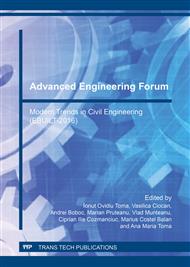p.255
p.262
p.272
p.280
p.286
p.294
p.301
p.309
p.319
Structural Behaviour Evaluation by Numerical Simulations for Innovative Solutions of Hybrid Lintels - Part 2: FEM Analysis
Abstract:
The paper presents a detailed analysis on the performance of reinforced concrete (RC)/ aerated autoclaved concrete (AAC) hybrid lintels, studied using finite element method (FEM), through numerical modelling. The analyzed lintels are a combination of modules, made of AAC and RC or pre-stressed concrete, which can be used for closing any span of windows or doors, for any wall thickness. To simulate the hybrid modules lintels in their service state, FEM modelling was used, together with rigorous numerical calculus, in order to better understand their flexural behaviour, the AAC-RC interface area and the way the material properties affect the structural performance of the analyzed lintels. The numerical analysis was initiated with validation of the reference model with analytically determined efforts in concrete component of the lintel. A subsequent model was constructed by adding the steel reinforcement and AAC component to the reference model. The analysis was conducted for two scenarios of a perfect and possibly very weak bond of RC/ AAC interface on “bonded interface model”, BIM and respectively “frictional interface model”, FIM models. The results showed that steel reinforcement had greater effect on the lintel`s stiffness than AAC component, while the effect of AAC is almost cancelled in the case of a weak bond of the interface. Future investigation needs to be developed considering an analytical model based on FIM model calibrated with laboratory measurements.
Info:
Periodical:
Pages:
286-293
Citation:
Online since:
March 2017
Price:
Сopyright:
© 2017 Trans Tech Publications Ltd. All Rights Reserved
Share:
Citation:


